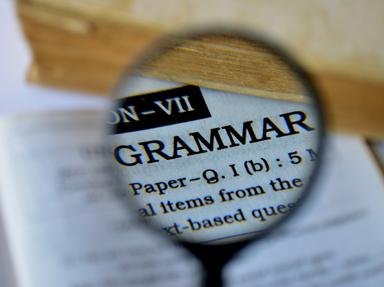Quiz Answer Key and Fun Facts
1. Because English punctuation, like English vocabulary, derived in part from other languages, we must first consider the languages of antiquity. In 196 BC, a pharaoh's decree was inscribed on what became known as the Rosetta stone. The decree was recorded in the scripts of three different languages, including hieroglyphics and Greek. Which of the following correctly reflects the punctuation used on the Greek portion of the Rosetta stone?
2. Although Aristophanes (c.257-180 BC), librarian of Alexandria, introduced the use of points (dots) to indicate different lengths of pauses in speech, his system did not come into wide use in the Greco-Roman era. However, punctuation marks that ultimately derived from his points are still in use today. Which of Aristophanes' punctuation points called for the longest pause?
3. "What need we any spur but our own cause to prick us to redress?" - Brutus in Shakespeare's "Julius Caesar".
Although the practice became less common as Greek culture and methods became more entrenched, ancient Romans sometimes placed a small prick mark between words to separate them. What · was · the · name · for · this · mark?
4. During medieval times, there were two punctuation "marks", spaces and points (dots). Spaces came to be used consistently to separate words. Points were used to indicate pauses. What determined the length of the pause?
5. During the Renaissance, in the 13th century, the printer Aldus Manutius set a standard by consistently using a period for a full stop and a slash to indicated a brief pause. Over time this slash shortened, migrated down and finally curled to become our modern comma. What term was used for the mark during the Renaissance?
6. It was during the Renaissance that a potentially subversive change in the purpose of punctuation occurred. Before that time, punctuation primarily signaled pauses for the purpose of elocution. But with the Renaissance, punctuation began to be used syntactically. Which of the following are syntactical aspects of punctuation use?
7. Although English writers used punctuation, they seemed to resist using the new fangled diacritical marks to clarify meaning or to delineate sentence structure. According to the 'Encyclopedia Britannica', "By the end of the 16th century writers of English were using most of the marks described by the younger Aldo in 1566; but their purpose was elocutionary, not syntactical." Which Elizabethan English author does the 'Encyclopedia Britannica' credit with first advocating syntactical punctuation in England?
8. Although punctuation demonstrably improves clarity and facilitates written communication, not all authors have embraced it. Consider the case of 18th century author Timothy Dexter whose book "A Pickle for the Knowing Ones" contained nary a jot nor tittle diacritical. What was Dexter's response to readers demanding that he amend his book?
9. Our exclamation point derives from the Latin word "io". The initial form of the exclamation mark was an upper case "I" placed atop a lower case "o". Which of the following words translates the Latin word "io"?
10. What will be the future of punctuation? New marks continue to be invented and the old punctuation marks used in new and creative ways :-). However, could it be that we will one day need a license to use the newest and most fashionable punctuation marks? Which of the following newer punctuation marks is not patented?
Source: Author
uglybird
This quiz was reviewed by FunTrivia editor
fringe before going online.
Any errors found in FunTrivia content are routinely corrected through our feedback system.

